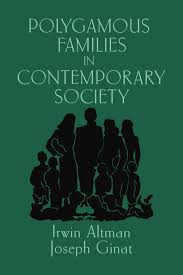Articles/Essays – Volume 30, No. 3
Fundamentalist Polygamists | Irwin Altman and Joseph Ginat, Polygamous Families in Contemporary Society
Irwin Altman, of the University of Utah, and Joseph Ginat, of the University of Haifa, one a social-environ mental psychologist, the other an anthropologist, studied twenty-seven contemporary polygamous families in the American West. They start with a brief history of polygyny (the technicalname for a man having several wives) in the Mormon church and the development of fundamentalist movements which continue to practice polygamy. They then describe their sample who live in a rural and an urban community. These families are numbered, and the communities have fictional names and general characteristics “for purposes of their anonymity.” The authors caution, “Many present-day fundamentalist communities are similar…. Readers are therefore advised not to leap to conclusions about the identities of people or groups” (61).
Altman and Ginat justify their small sample by explaining they wanted to look at a few families in depth. They visited the informants in their homes, talked on the telephone, invited family members to Altman’s home, and met in restaurants. From 1987 to 1992 they conducted 189 inter views or observations. Frequently both authors were present; both kept field notes. From these they compiled information about marriages, home life, schedules, and connections be tween family members. They compare the dyadic (two individuals such as a husband and wife) and communal relationships. While they found no “typical” families, they concluded that in most families the focus was on the link between the husband and wife or the wife and her children rather than the husbands, wives, and children working together as a unit. Their explanations increased my understanding of current polygamous families.
Each chapter highlights one aspect of contemporary polygyny. For example, there are chapters on court ship patterns, marriage ceremonies, living arrangements, and schedules. First, the authors summarize the experiences of polygynous societies throughout the world. After giving this background, they review the experiences of several families from their sample. Stories of nineteenth century Mormons (from secondary sources) are included in the middle of this discussion to show that the con temporary families are very similar to LDS church-sanctioned marriages.
Occasionally the authors even slip and call their study group “Mormon plural families” (218). I am of fended because, although the fundamentalists believe they are following Mormon traditions, technically they are not Mormons. I would prefer to see the Mormons included in the background information rather than mixed into the discussion on the contemporary families, almost implying that the current polygamous groups are Mormons.
I am also uncomfortable with the way that my work on Mormon Polygamous Families: Life in the Principle (Salt Lake City: University of Utah Press, 1987) and other studies of nineteenth century Mormon polygamy are cited. For example, the authors include stories and statistics from my study as if I were talking about a norm and not a limited sample based on oral history interviews with children. They also depend too heavily on just a few secondary sources. They refer to my citation of Lowell “Ben” Bennion’s study of Davis County and Washington County polygamists when Bennion’s article is easily available.
Polygamous Families in Contemporary Society is an interesting study of a limited number of plural families in the West today. However, the families should have been studied based on their own merits. There are too many attempts to make them into Mormons.
Polygamous Families in Contemporary Society. By Irwin Altman and Joseph Ginat (New York: Cambridge University Press, 1996).


 Back to full Issue
Back to full Issue

